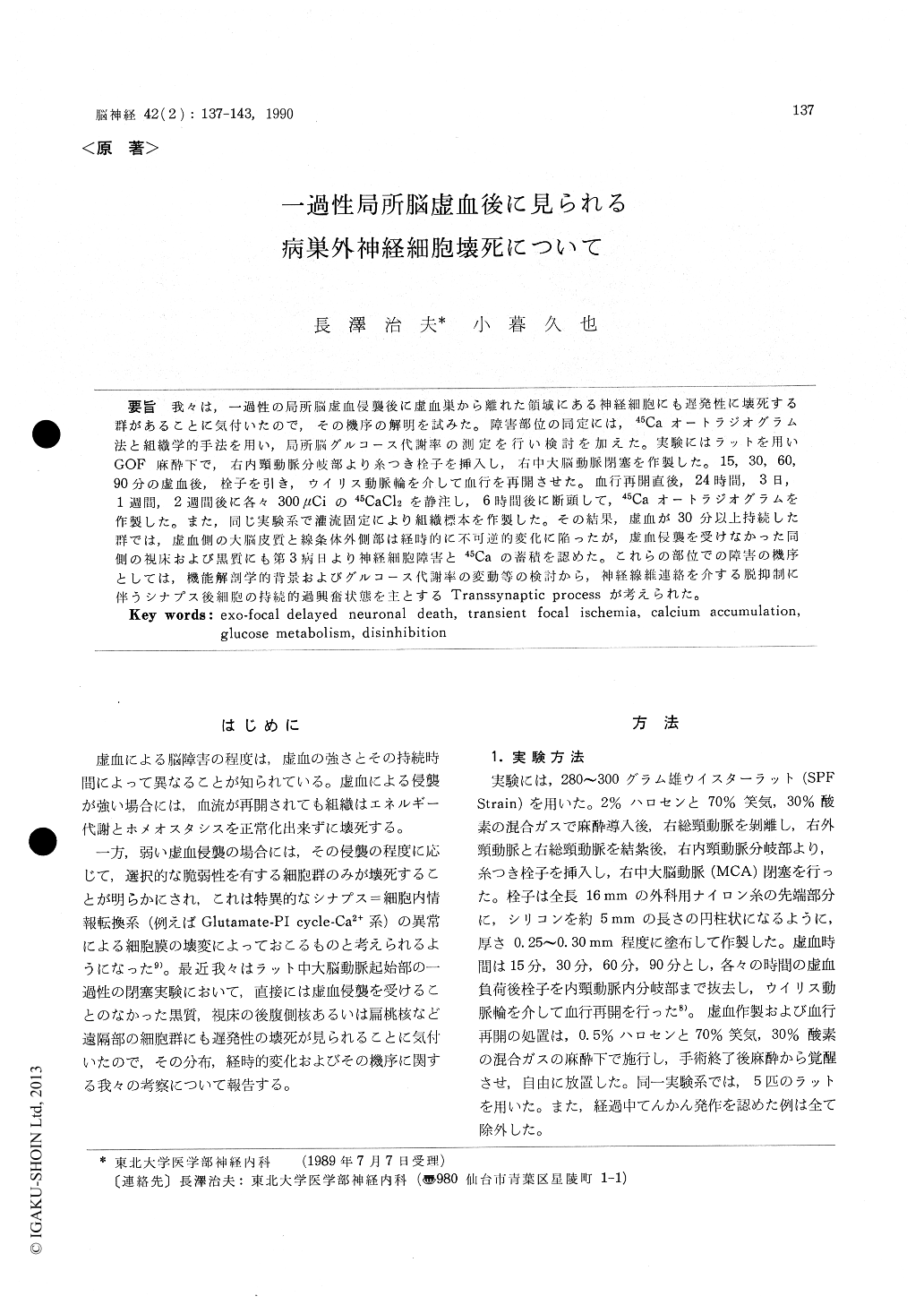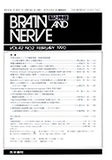Japanese
English
- 有料閲覧
- Abstract 文献概要
- 1ページ目 Look Inside
我々は,一過性の局所脳虚血侵襲後に虚血巣から離れた領域にある神経細胞にも遅発性に壊死する群があることに気付いたので,その機序の解明を試みた。障害部位の同定には,45Caオートラジオグラム法と組織学的手法を用い,局所脳グルコース代謝率の測定を行い検討を加えた。実験にはラットを用いGOF麻酔下で,右内頸動脈分岐部より糸つき栓子を挿入し,右中大脳動脈閉塞を作製した。15,30,60,90分の虚血後,栓子を引き,ウイリス動脈輪を介して血行を再開させた。血行再開直後,24時間,3日,1週間,2週間後に各々300μCiの45CaCl2を静注し,6時間後に断頭して,45Caオートラジオグラムを作製した。また,同じ実験系で灌流固定により組織標本を作製した。その結果,虚血が30分以上持続した群では,虚血側の大脳皮質と線条体外側部は経時的に不可逆的変化に陥ったが,虚血侵襲を受けなかった同側の視床および黒質にも第3病日より神経細胞障害と45Caの蓄積を認めた。これらの部位での障害の機序としては,機能解剖学的背景およびグルコース代謝率の変動等の検討から,神経線維連絡を介する脱抑制に伴うシナプス後細胞の持続的過興奮状態を主とするTranssynaptic processが考えられた。
We describe delayed neuronal damage in ipsi-lateral remote areas outside the ischemic area of rat brain after transient focal ischemia. The dis-tribution of the neuronal damage was determined by using the 45Ca autoradiographic technique and the histological mehtod, and we investigated the mechanism involved by measuring local cerebral glucose metabolism. Wistar rats were used throughout the experiments. Under 2% halothane anesthesia with a mixture of 70% N2O and 30% O2, the right middle cerebral artery (MCA) was embolized by insertion from the internal carotid artery of a nylon surgical thread with a cylindrical coating of silicone on the distal portion. Animals were divided into 4 groups based on duration of ischemia. After 15, 30, 60 and 90 min of MCA occlusion, recirculation was achieved by removal of the embolus. Immediately after recirculation and then after 24 hr, 3 days, 1 week and 2 weeksof recirculation, 300 μCi 45CaCl2 in aqueous solution (0. 3 ml) was administered intravenously ; 6 hr later, animals were decapitated to obtain auto-radiograms. Histological examination was carried out according to the same protocal.
In the 15-min MCA occlusion group, neither 45Ca accumulation nor histological change was obser-ved. In the 30-min MCA occlusion group, 45Ca accumulation extended from the lateral margin to the lateral segment of the caudate-putamen and the cerebral cortex supplied by the occluded MCA depending on the duration of recirculation. After 30 min of MCA occlusion followed by the 3 days of recirculation, 45Ca had accumulated in the ipsi-lateral substantia nigra (pars reticularis), and also after 2 weeks of recirculation, 45Ca accumulation was observed in the ipsilateral ventral posterior nucleus of the thalamus. In the 60- and 90-min MCA occlusion groups, remarkable 45Ca accumulation was observed in the occluded MCA areas. Moreo-ver, at the delayed intervals, these changes were seen in the remote areas outside the ischemic area. Histological examination revealed that the neu-rons were reduced in number and suffered damage in varying degrees in the ipsilateral ventral pos-terior nucleus of the thalamus and the substantia nigra in proportion to the duration of recirculation after ischemic insult. Neither the reduction of blood flow nor brain edema was detectable in these remote areas.
Local cerebral glucose utilization, measured by the 14C-deoxyglucose autoradiographic method, decreased, by varying degrees in the ipsilateral thalamus, but increased in the substantia nigra. Both areas lie outside the ischemic area, but have transsynaptic connections with the ischemic focus. Based on the present study, we speculate that the mechanisms of delayed neuronal death in both remote areas may not be identical, but that this phenomenon may be caused by a transsynaptic process associated with the ischemic focus.

Copyright © 1990, Igaku-Shoin Ltd. All rights reserved.


